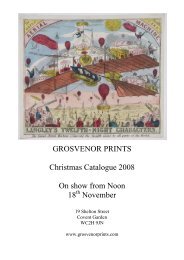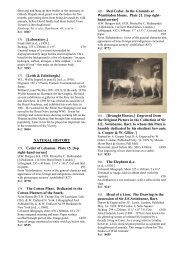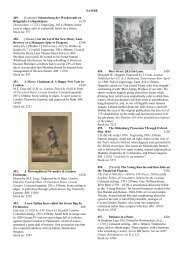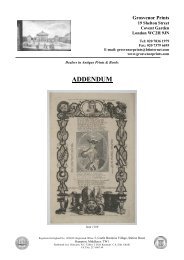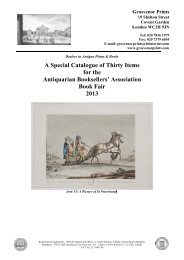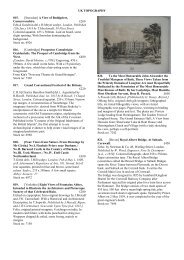cat2 09.pdf - Grosvenor Prints
cat2 09.pdf - Grosvenor Prints
cat2 09.pdf - Grosvenor Prints
Create successful ePaper yourself
Turn your PDF publications into a flip-book with our unique Google optimized e-Paper software.
the Duke of Kingston's stud in 1774 and of the stud of<br />
the Prince of Wales (afterwards George IV) in 1786.<br />
Plate to Volume III of Rudolph Ackermann's<br />
'Microcosm of London', 3 vols., 1808-10.<br />
Numbered 'Plate 83.' upper right.<br />
Abbey, Scenery of Great Britain and Ireland: 212, 83.<br />
9867 View Of The Tower.<br />
Rowlandson & Pugin delt. et sculpt. Sunderland, aquat.<br />
London Pub. Octr. 1st. 1809, at R. Ackermann’s<br />
Repository of Arts 101 Strand.<br />
Hand coloured aquatint, 230 x 280mm. 9 x 11". Slight<br />
offsetting. £230<br />
Tower Hill, London.<br />
Plate to Volume III of Rudolph Ackermann's<br />
'Microcosm of London', 3 vols., 1808-10.<br />
Numbered 'Plate 85, Second.' upper right. On<br />
Whatman paper watermarked 1808.<br />
Abbey, Scenery of Great Britain and Ireland: 212, 85.<br />
9873 St. Luke's Hospital.<br />
Rowlandson & Pugin delt. et sculpt. J.C. Stadler aquat.<br />
London Pub, Augt. 1st. 1809, at R. Ackermann’s<br />
Repository of Arts 101, Strand.<br />
Hand coloured aquatint, 230 x 275mm. 9 x 10¾". £140<br />
St Luke's Hospital for Lunatics was founded in London<br />
in 1751 for the treatment of incurable lunatics. It was<br />
the second public institution in London created to look<br />
after mentally ill people, after the Hospital of St. Mary<br />
of Bethlem (Bedlam, founded in 1246). The hospital<br />
was originally housed in a converted foundry in<br />
Windmill Street, Upper Moorfields, close to Bedlam. It<br />
moved to purpose-built premises on Old Street, on the<br />
north-west corner of Providence Row, in 1786. Behind<br />
the main building were two gardens for the exercise of<br />
the less disturbed inmates, one for men and another for<br />
women. The patients were transferred to other<br />
institutions in 1916, and the buildings were acquired by<br />
the Bank of England to become the St Luke's Printing<br />
Works, used for printing bank notes until the early<br />
1950s.<br />
Plate to Volume III of Rudolph Ackermann's<br />
'Microcosm of London', 3 vols., 1808-10.<br />
Numbered 'Plate 77.' upper right.<br />
Abbey, Scenery of Great Britain and Ireland: 212, 77.<br />
9874 Drawing Room St. James's.<br />
Rowlandson & Pugin delt. et sculpt. J. Bluck aquat.<br />
London Pub. July 1st. 1809, at R. Ackermann’s<br />
Repository of Arts 101 Strand.<br />
Hand coloured aquatint, 235 x 280mm. 9¼ x 11". £180<br />
A social gathering in a plush interior at St. James's<br />
Palace.<br />
Plate to Volume III of Rudolph Ackermann's<br />
'Microcosm of London', 3 vols., 1808-10.<br />
Numbered 'Plate 76.' upper right.<br />
Abbey, Scenery of Great Britain and Ireland: 212, 76.<br />
9860 Chelsea Hospital.<br />
Rowlandson & Pugin delt. et sculpt. J. Bluck aquat.<br />
London Pub. Jany. 1st. 1810 at R. Ackermann’s<br />
Repository of Arts 101 Strand.<br />
Hand coloured aquatint, 235 x 280mm. 9¼ x 11". £160<br />
Interior view of the dining hall at the Royal Hospital<br />
Chelsea, the Chelsea Pensioners eating.<br />
Plate to Volume III of Rudolph Ackermann's<br />
'Microcosm of London', 3 vols., 1808-10.<br />
Numbered 'Plate 98.' upper right.<br />
Abbey, Scenery of Great Britain and Ireland: 212, 98.<br />
9876 Somerset House, Strand.<br />
Rowlandson & Pugin delt. et sculpt. Bluck aquat.<br />
London Pub. 1st. June 1809, at R. Ackermann’s<br />
Repository of Arts 101, Strand.<br />
Hand coloured aquatint, 230 x 275mm. 9 x 10¾". £230<br />
The courtyard of Somerset House.<br />
Plate to Volume III of Rudolph Ackermann's<br />
'Microcosm of London', 3 vols., 1808-10.<br />
Numbered 'Plate 73.' upper right.<br />
Abbey, Scenery of Great Britain and Ireland: 212, 73.<br />
9769 Nocturne: Westminster [in pencil<br />
lower left.]<br />
Leslie M Ward imp 1921 [signed in pencil lower right.]<br />
Etching, 125 x 275mm. 5 x 10¾". £160<br />
An atmospheric view at night of 'Big Ben' and<br />
Westminster looking up the River Thames, Canon<br />
Street Railway Bridge in the foreground. A tugboat<br />
pulling Thames barges passes underneath the bridge.<br />
Leslie Moffat Ward, RE (1888 - 1978) was a painter<br />
and etcher with a particular interest in the structural<br />
qualities of both the built environment and the<br />
landscape.<br />
9878 Royal Exchange.<br />
Rowlandson & Pugin delt. et sculpt. Hill, aquat.<br />
London Pub. 1st. May 1809, at R. Ackermann’s<br />
Repository of Arts 101, Strand.<br />
Hand coloured aquatint, 230 x 270mm. 9 x 10½". Faint<br />
offsetting to image. £220<br />
The courtyard of the Royal Exchange in the City of<br />
London, founded in 1565 by Sir Thomas Gresham to<br />
act as a centre of commerce for the city. The Royal<br />
Exchange was officially opened by Queen Elizabeth I<br />
who awarded the building its Royal title, on 23 January<br />
1571. Gresham's original building was destroyed in the<br />
Great Fire of London in 1666. The building depicted<br />
here is the second exchange built on the site, designed<br />
by Edward Jerman, which opened in 1669, and which<br />
was also destroyed by fire in January 1838.<br />
Plate to Volume III of Rudolph Ackermann's<br />
'Microcosm of London', 3 vols., 1808-10.<br />
Numbered 'Plate 67.' upper right.<br />
Abbey, Scenery of Great Britain and Ireland: 212, 67.<br />
9879 Queen's Palace, St. James's Park.<br />
Rowlandson & Pugin delt. et sculpt. Bluck, aquat.<br />
London Pub. 1st. May 1809, at R. Ackermann’s<br />
Repository of Arts 101, Strand.<br />
Hand coloured aquatint, 230 x 275mm. 9 x 10¾". £260<br />
Buckingham House, the building which forms the core<br />
of today's Buckingham Palace, was a large townhouse<br />
built for the Duke of Buckingham in 1703 and acquired<br />
by George III in 1761as a private residence, known as<br />
"The Queen's House". It was enlarged over the next 75<br />
years, principally by architects John Nash and Edward


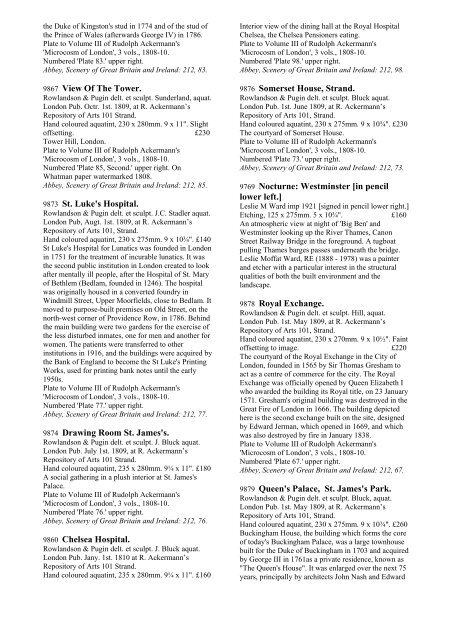

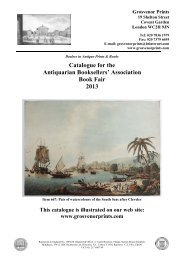
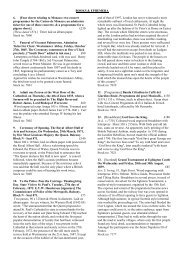
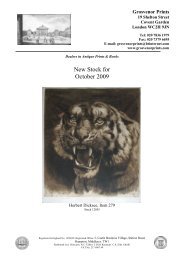
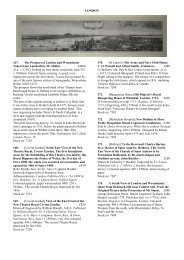
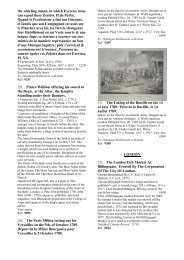
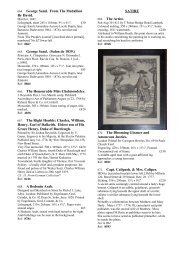
![FOREIGN TOPOGRAPHY 661. [Niagara] The ... - Grosvenor Prints](https://img.yumpu.com/38432042/1/184x260/foreign-topography-661-niagara-the-grosvenor-prints.jpg?quality=85)
